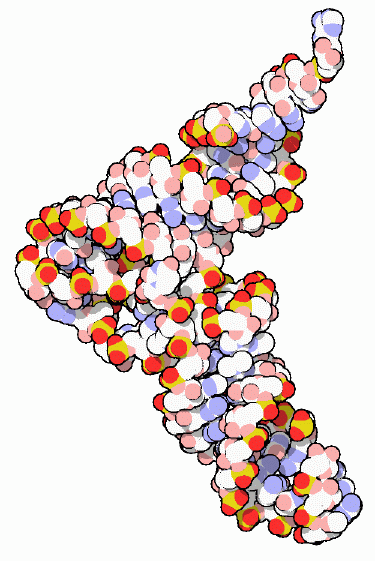|
Inhaltsübersicht | Nanomaschinen | Moleküle | Programme | Kurse | Fun | Links |
||
| > |
Transfer RNA
Next: Transfer RNA Structure
Since the process of DNA-directed protein synthesis was discovered, scientists and philosophers have searched, more or less seriously, for a relationship between the triplet nucleic acid codons and the chemical nature of the amino acids. These attempts have been uniformly unsuccessful, but remain an occasional topic of speculation because of their possible insights into the origins of life. There does not appear to be a specific interaction between the codons and the amino acids themselves. Instead, the match is made by transfer RNA, the Rosetta Stone that translates the nucleotide language of codons into the amino acid language of proteins. This translation is physical and direct: at one end of each tRNA is an anticodon that recognizes the genetic code, and at the other end is the appropriate amino acid for that code.
High Fidelity
Errors in the production of proteins can occur at both ends of the tRNA. The proper amino acid must be added to the tip of tRNA, ready to be added to a growing protein chain. A battery of enzymes, termed amino-acyl tRNA synthases, are in charge of this job. They generally make a mistake in about one out of every ten thousand tRNA molecules that they charge with an amino acid. We'll look more carefully at these fascinating proteins next month. Errors may also occur at the other end of the tRNA, when the anticodon matches up with a codon. It may simply match improperly--this happens about one time in five hundred. Or, because each codon is three nucleotides long, it may associate in a shifted position, instead of the proper reading frame. This will throw off the rest of the protein, as each successive tRNA lines up in the wrong position after the shifted one. Fortunately, when genetic sequences are read in the wrong frame, they are filled with STOP codons, so the protein synthesis will be aborted after a few dozen more amino acids are added.
Making the Most of a Bad Situation
Biological evolution is remarkable in its ability to benefit from shortcomings. If there is any way that a problem can be made into an asset, the process of natural selection will find it eventually. Errors in protein synthesis are no exception. Both the mismatch of codon with anticodon and the shifting of reading frames play special functional roles in certain organisms. In many places, different codons are used as START signals. The codons may be GUG, UUG, or AUU, but all use the same methionine tRNA, which normally recognizes the codon AUG. In order for these proteins to be made, the methionine tRNA must pair with these erroneous codons. Shifting of the reading frame is essential in the lifecycle of HIV. When making the long polyprotein, which contains all of the proteins that are found inside the virus, ribosomes make a mistake in one place about 5% of the time, aligning a tRNA incorrectly and shifting the reading frame. This causes the ribosome to miss the normal STOP codon, so a much longer protein is made. These occasional errors are critical for the life of the virus, because the longer proteins contain the enzymes that transcribe the viral genome.
Last changed by: A.Honegger,
